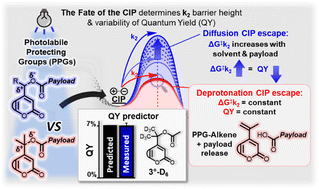The fate of the contact ion pair determines the photochemistry of coumarin-based photocleavable protecting groups†
Abstract
Photocleavable protecting groups (PPGs) enable the precise spatiotemporal control over the release of a payload of interest, in particular a bioactive substance, through light irradiation. A crucial parameter that determines the practical applicability of PPGs is the efficiency of payload release, largely governed by the quantum yield of photolysis (QY). Understanding which parameters determine the QY will prove crucial for engineering improved PPGs and their effective future applications, especially in the emerging field of photopharmacology. The Contact Ion Pair (CIP) has been recognized as an important intermediate in the uncaging process, but the key influence of its fate on the quantum yield has not been explored yet, limiting our ability to design improved PPGs. Here, we demonstrate that the CIP escape mechanism of PPGs is crucial for determining their payload- and solvent-dependent photolysis QY, and illustrate that an intramolecular type of CIP escape is superior over diffusion-dependent CIP escape. Furthermore, we report a strong correlation of the photolysis QY of a range of coumarin PPGs with the DFT-calculated height of all three energy barriers involved in the photolysis reaction, despite the vastly different mechanisms of CIP escape that these PPGs exhibit. Using the insights obtained through our analysis, we were able to predict the photolysis QY of a newly designed PPG with particularly high accuracy. The level of understanding of the factors determining the QY of PPGs presented here will move the ever-expanding field of PPG applications forward and provides a blueprint for the development of PPGs with QYs that are independent of payload-topology and solvent polarity.

- This article is part of the themed collection: 2024 Chemical Science HOT Article Collection


 Please wait while we load your content...
Please wait while we load your content...